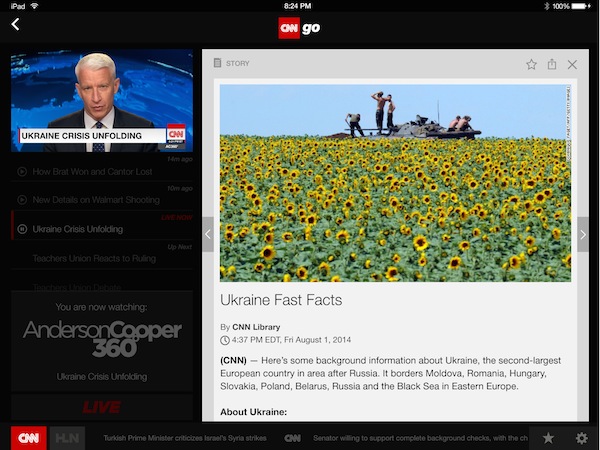
It’s 2014, and if you want to, you can watch cable news live on a mobile device from pretty much anywhere. It might well stream poorly, and you’ll have a hard time figuring out how to log in to (or “authenticate”) your account, but you can do it.
TV Everywhere has begun to make simulcasting available from a variety of networks and channels — according to Adobe’s state-of-the-industry report (via The New York Times), viewership has grown 246 percent in the last year. Companies have started experimenting with what’s possible in terms of bringing broadcast TV content to smartphones and tablets. For example, NBC notably broke traffic records with its Olympics coverage last fall, which was pushed out live on mobile. WatchESPN has also been remarkably popular.
But over the summer, CNN has rolled out a product meant to go above and beyond what competitors offer when it comes to live, mobile TV news. Of its competitors, CNN’s Alex Wellen says, “They’re usually one app, for one show on one network that’s probably pre-baked and planned for and needs to be synchronized. So I think it’s a different proposition altogether.”
The proposition he’s referring to is CNNgo, which originally launched as CNNx in April. Available on iPad or desktop, CNNgo can be accessed by TV Everywhere subscribers who can remember their cable login and password.1 The new name — CNNgo mirrors the successful HBO GO as well as CNN’s new slogan, “Go There” — will bring with it a week of no-authentication-needed streaming that includes bonus content from Anthony Bourdain, Mike Rowe, and Lisa Ling. CNN is hoping the combination of exclusive on-demand content and an authentication-free experience will seduce users into testing — and falling for — the product.
“CNNx is all about control, whether it’s controlling what you watch or when you watch, how much depth you get around a particular segment, how you share it, how you personalize it — it really was about control,” says Wellen, vice president of product, strategy, and operations. “The control in the past had always been inside the control room. The director decided what segments came up. Our goal was to put the consumer inside the control room. When we knew it, you knew it.”
When you open up CNNgo, it starts playing whatever’s currently on CNN. Along the bottom, you’ll see a few choice, curated links from social media — photos, tweets — selected by a CNNgo standalone editorial team.

But the real feature is a sidebar that allows users to both look ahead at the day’s rundown as well as scroll back and watch already aired content from the last 24 hours. So, if you’re not interested in watching Wolf Blitzer talk about climate change at 1 p.m., you can go back and watch Obama’s comments on ISIS from 10 a.m. while you wait for a segment on the IDF to air around 1:45. Thus is the traditional, top-down, linear model for broadcast TV tweaked into a digital approach that allows users to choose what they watch — at least within the world of already-aired CNN content.

CNNgo squares nicely with the network’s “always on” public image. The difference between an app like this and other second screen and TV Everywhere apps, according to Wellen, is the ability (or ambition) to handle breaking news.
“If there’s breaking news, first, pictures come in. We can deliver that in the app. You can see those first pictures, as opposed to waiting for it to come on the screen,” he says. “In most other scenarios, if something happens unexpected, the app falls apart. This app actually thrives when there’s breaking news, which is exactly what CNN is.”
As far as what kind of audience CNNgo has brought in thus far, Wellen would only say that it’s “early days” for the product.2 But TV Everywhere viewership continues to climb for CNN, with August breaking all previous records. More impressive is the average time spent per user — a somewhat astounding (and almost TV-like) 47 minutes on the iPad and 104 minutes on desktop.
That kind of time investment is, of course, music to the ears of advertisers. Video content is already a solid proposition for marketers, but CNNgo offers something more — data about individual users and the exact segments they do and don’t want to watch. Someday, information on what content viewers click on and what content they choose to ignore might even inform coverage.
“Should the focus be on engagement…whether they’re staying in this experience longer, how many segments they’re watching? That could inform some of our programming,” says Wellen. “The segments that are performing better, where we lose people in a particular story, that could inform a lot of what we do across all platforms.”
CNNx launched initially on iPad because the device fit both the “lean in” and “lean back” experience, Wellen says. The move to desktop was mostly aimed at getting more viewers interested. For now, the iPhone screen is a little small for all of CNNgo’s functionality, but someday CNNgo will be the standard face of CNN across platforms.
“The reality is people want to time shift and get context and share TV wherever they are. It will be, I think, critical for us to put that in the palm of your hand, which is your phone,” says Wellen. “I would say that what we’re doing with this product is really setting the future architecture for CNN.”